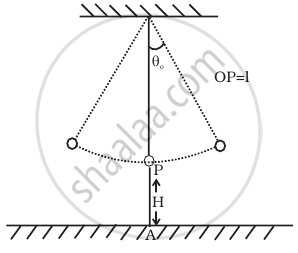Advertisements
Advertisements
प्रश्न
Which of the following statements is/are true for a simple harmonic oscillator?
- Force acting is directly proportional to displacement from the mean position and opposite to it.
- Motion is periodic.
- Acceleration of the oscillator is constant.
- The velocity is periodic.
उत्तर
a, b and d
Explanation:
Simple harmonic motion is a type of periodic motion or oscillation motion where the restoring force is directly proportional to the displacement and acts in the direction opposite to that of displacement. When the system is displaced from its equilibrium position, a restoring force that obeys Hooke’s law tends to restore the system to equilibrium. As a result, it accelerates and starts going back to the equilibrium position.
An oscillation follows simple harmonic motion if it fulfils the following two rules:
- Acceleration is always in the opposite direction to the displacement from the equilibrium position.
- Acceleration is proportional to the displacement from the equilibrium position.
Let us write the equation for the SHM x = a sin(ωt + `phi`)
Clearly, it is a periodic motion as it involves since function.
Let us find velocity of the particle, `v = (dx)/(dt)`
= `d/(dt) (a sin(ωt + phi))`
= `aω cos(ωt + phi)`
Velocity is also periodic because it is a cosine function.
Now let us find acceleration, `A = (dv)/(dt)`
= `(d^2x)/(dt^2)`
= `- aω^2 sin(ωt + phi)`
The acceleration is a sine function, hence cannot be constant.
⇒ `A = - (ω^2a) sin(ωt + phi) = - ω^2x`
Force, F = Mass × Acceleration
= mA
= – mω2x
Hence, force acting is directly proportional to displacement from the mean position and opposite to it.
APPEARS IN
संबंधित प्रश्न
The period of a conical pendulum in terms of its length (l), semi-vertical angle (θ) and acceleration due to gravity (g) is:
When the length of a simple pendulum is decreased by 20 cm, the period changes by 10%. Find the original length of the pendulum.
The phase difference between displacement and acceleration of a particle performing S.H.M. is _______.
(A) `pi/2rad`
(B) π rad
(C) 2π rad
(D)`(3pi)/2rad`
A spring having with a spring constant 1200 N m–1 is mounted on a horizontal table as shown in Fig. A mass of 3 kg is attached to the free end of the spring. The mass is then pulled sideways to a distance of 2.0 cm and released.

Determine (i) the frequency of oscillations, (ii) maximum acceleration of the mass, and (iii) the maximum speed of the mass.
A clock regulated by seconds pendulum, keeps correct time. During summer, length of pendulum increases to 1.005 m. How much will the clock gain or loose in one day?
(g = 9.8 m/s2 and π = 3.142)
Show that motion of bob of the pendulum with small amplitude is linear S.H.M. Hence obtain an expression for its period. What are the factors on which its period depends?
When will the motion of a simple pendulum be simple harmonic?
A body of mass m is situated in a potential field U(x) = U0 (1 – cos αx) when U0 and α are constants. Find the time period of small oscillations.
Consider a pair of identical pendulums, which oscillate with equal amplitude independently such that when one pendulum is at its extreme position making an angle of 2° to the right with the vertical, the other pendulum makes an angle of 1° to the left of the vertical. What is the phase difference between the pendulums?
A simple pendulum of time period 1s and length l is hung from a fixed support at O, such that the bob is at a distance H vertically above A on the ground (Figure). The amplitude is θ0. The string snaps at θ = θ0/2. Find the time taken by the bob to hit the ground. Also find distance from A where bob hits the ground. Assume θo to be small so that sin θo = θo and cos θo = 1.

